The garden continues to wake up around me. I took a little walkabout to decide what to write about this week and was thrilled to see bulbs peeking out of the soil and swelling buds on shrubs. I was surprised to find it was difficult to choose my six pictures for today.
Hellebores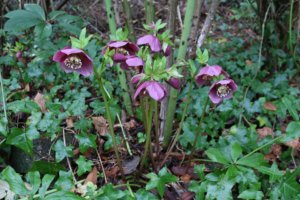
Hellebores are one helluva plant. Cold winters or unseasonally warm ones – they care not. Up they pop with their gorgeous freckled faces, bashfully pointing downwards. The almost tropical form and subtle colour variations can only really be appreciated by getting close and tipping their flower heads upward.
I once visited Highgrove, Prince Charles’ country house, and saw that he had planted hellebores up high in the stumpery. You could look up into their faces as you walked, stumps planted with mosses and flowers piled artfully on either side of the path.
In my own garden I have to get down on my knees to take pictures. If you do have hellebores in your garden or see any elsewhere it’s well worth the dirty jeans so they can be fully admired.
Cyclamen coum – winter/spring flowering cyclamen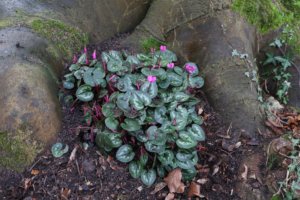
Last autumn I planted a few corms of cyclamen coum, the winter flowering variety of the cyclamen family. I had admired a clump growing in the nook of some roots of a neighbourhood tree and wanted the same affect at the foot of my gorgeous copper beech tree.
Two days after planting, I inspected the site and realised they had been dug up – probably by a squirrel.
My new friend the snowdrop man came to the rescue this week. He called up so say he had some cyclamen coum clumps that had been spread round his garden by ants. If I popped round I could dig some up. Expecting a few small clumps I went round with my little trug and hand trowel.
“That won’t do the trick” he said. “You’ll need to borrow my spade.”
He pointed to a huge clump of deep green, silver veined leaves, smothered in magenta pink flowers. I was disbelieving that he was willing to give it away, but overjoyed. Using his spade I managed to dig up the clump intact and here it is, resplendent in its tree nook home. Even if my corms had survived the squirrel attack, it would have been some years before this effect would have been achieved.
I’m a lucky girl.
Cyclamen hederifolium – autumn flowering cyclamen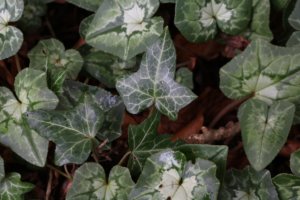
A little teaser for you all. Can you spot the leafy interlopers in this picture?
Here’s a clue – the latin suffix hederifolium means “Ivy leaved”.
Well, nestled in the middle of a large clump of silver pattered cyclamen hederifolium are some leaves of ivy Hedera helix.
If you’re ever wondering what cyclamen you’re looking at, this is worth remembering. Leaves of cyclamen coum have more rounded tips.
Do I need a grow light?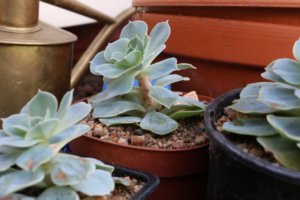
Last week the host of the Six on Saturday collective, The Propagator, shared a picture of his greenhouse, illuminated purple at night with a new grow light. It was impressive, but I had never felt I needed kit like this.
Two days later I realised that maybe I did need kit like this.
The succulent offsets that I separated from my Echeveria plant back in the autumn (see Six on Saturday 13.10.18), have started to extend. The technical term for this process is etiolation and is caused by the plant stretching out in search of light.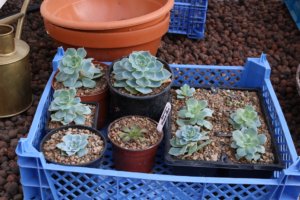
This should be remedied by moving them to a high shelf where they’re not overshadowed by other plants, and also moving them to the cooler part of the greenhouse so that they’re not actively growing. Meanwhile I need to decide whether to follow the Propagator’s lead on a grow light…
King Protea – protea cynaroides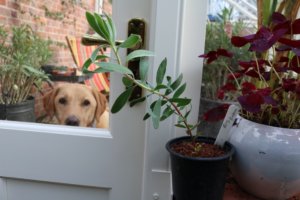
My labrador doesn’t like it when there’s a shut door between he and I, hence his guest appearance in this shot of my King Protea seedling.
A birthday gift from a friend, a little packet of seeds sown last spring has become this lovely plant. If you’re wondering what the flower of this South African beauty looks like, here’s a picture of the wallet that came along with my Kew gardens annual membership card. It’s easy to see why Kew chose this image.
My plant, like the echeveria, may be suffering with a spot of etiolation, as it is quite leggy. I’m a bit at a loss to know how to handle it from here. Should I prune it and hope it branches? Or do I support it and see how it grows from here? I’m favouring the latter whilst I research further.
One thing I do know is that it needs repotting as the roots are beginning to poke out of the bottom of the little pot. You should be able to spot pine needles as a mulch on the top of the soil – I read this was a good idea as the pine needles are acidic and King Proteas like acid soil.
Mahonia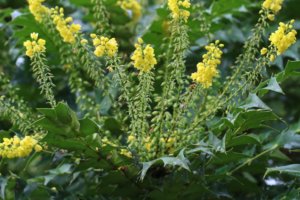
I have a love hate relationship with Mahonia. Most of the year, despite its majestic form, it’s an evil looking plant. The dark green, glossy leaves are so so spiky. Don’t go near one without protection.
At this time of year though, they really enhance a garden with their pretty yellow flowers and sweet wafting scent, providing valuable winter nectar for insects. Mine is planted on a boundary fence and it provides excellent year round screening from the neighbours.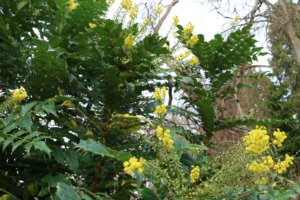
I was a bit late with my photographs here as the flowers are now a bit elongated but the effect from a distance is still stunning.
Six on Saturday is a weekly meme – take a look at the comments at the base of host The Propagator to see more ‘sixes’ from other keen gardeners from all over the world.

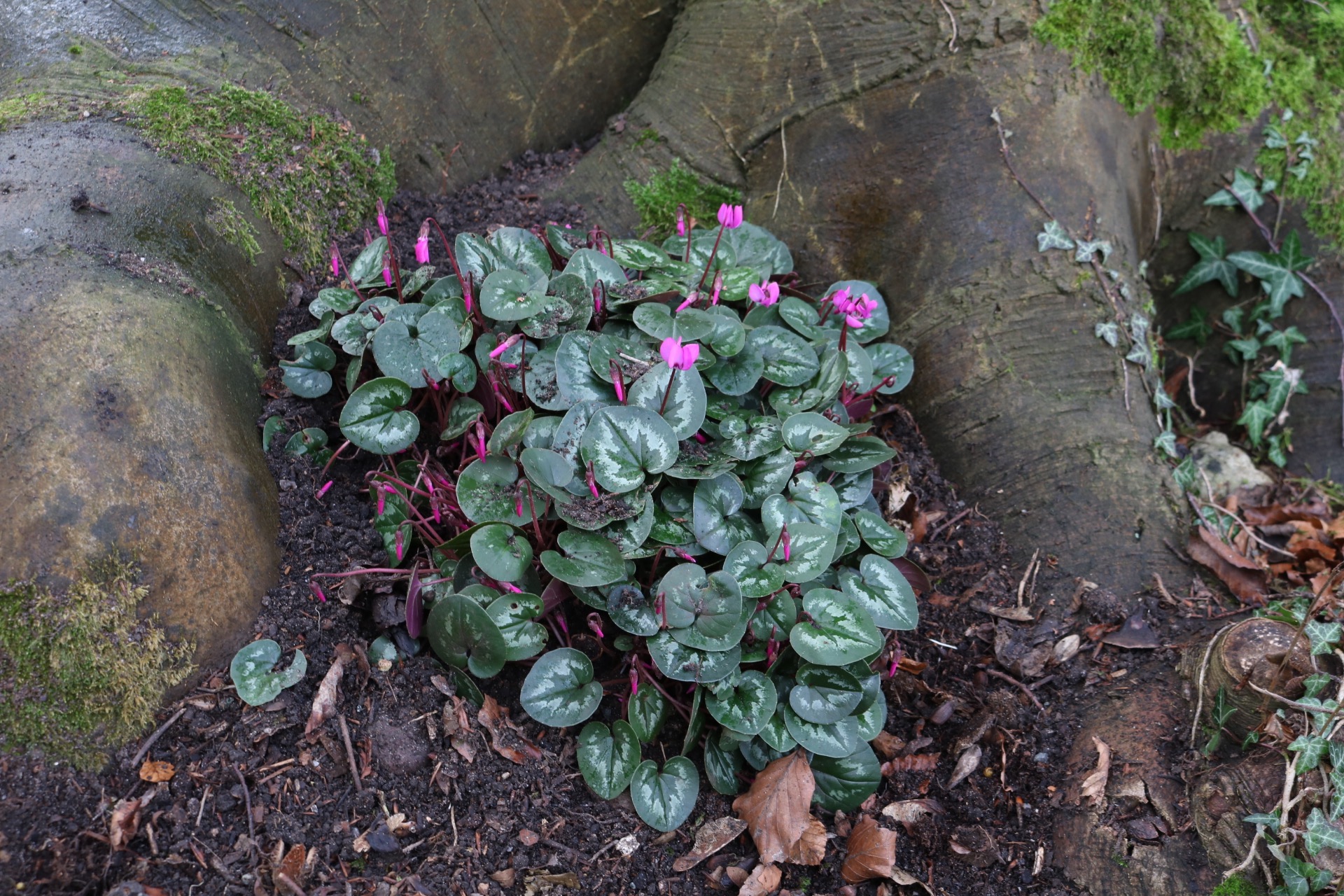
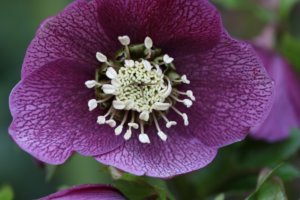
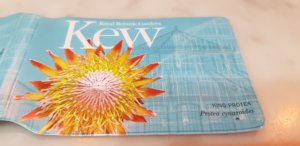
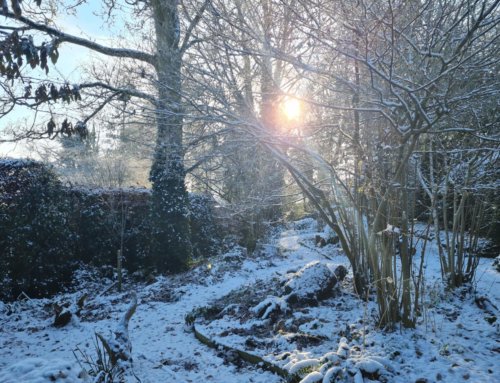
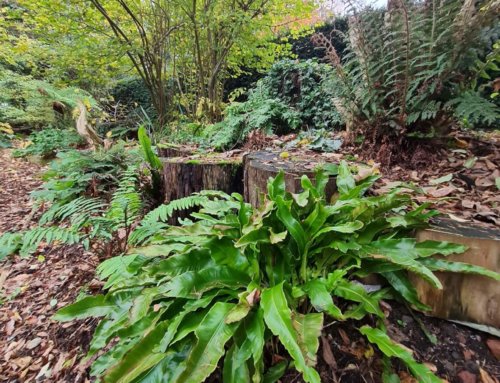
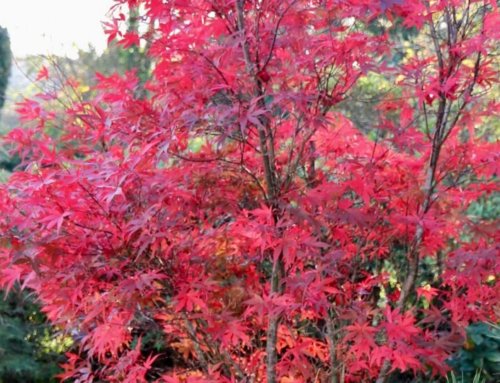
Proteas are so difficult to succeed that you have the right to prevent your dog from entering so that a pot doesn’t fall accidentally … How did you manage to sow them? I tried and failed, even though my soil was an acid soil.
Lovely Six Katharine and nice pictures as always.
Beautiful pictures and plants, Katharine. The Cyclamen coum look absolutely at home. I have the same variety in the graveyard and they do spread very happily in the right conditions, so will be looking for opportunities to copy your move.
I suppose those plants that evolved in more evenly lit environments will etiolate during our Winters, but whether cutting them back or getting in more light is the right way to go, only you can decide!
Hi Tim. I do hope you find some good plants to transplant. I’m hoping these will spread, as you say. They’re pretty near my clump of cyclamen hederifolium, which is doing well so I’m optimistic.
Wow — jealous you have a Snowdrop man, but even moreso that you now have that beautiful Cyclamen now! Your garden has such pretty color in January. The Mahonia is impressive!
Hi Laura – the snowdrop man is so knowledgable and generous. It’s so nice to have a lovely local kindred spirit for gardening chat. I’ll be passing on more info on snowdrops through this blog so keep checking in.
Proteas are very sensitive to phosphate, you want low nutrient levels generally but especially of phosphate. Then good air circulation and perfect drainage, especially over winter. Good luck. Cracking clump of Cyclamen, one day mine will be like that, I hope.
Your Snowdrop man is lovely! What a fabulous gift the Cyclamen are and they look so at home where you have planted them.
I need a snowdrop man. As it were. I confess i don’t like the look of mahonia. Not one I’m in a hurry to get in my garden. Hellebores though, those i do need more of.
Everyone needs a snowdrop man. Years of gardening knowhow and generous with knowledge and plants. I look forward to seeing what hellebores you choose – or maybe you’ll grow from seed…